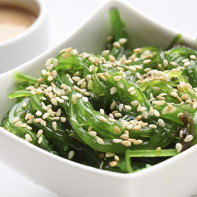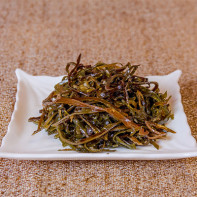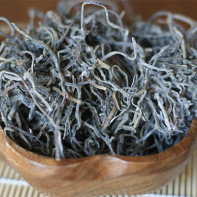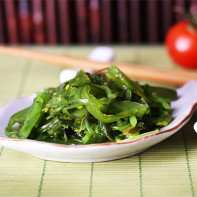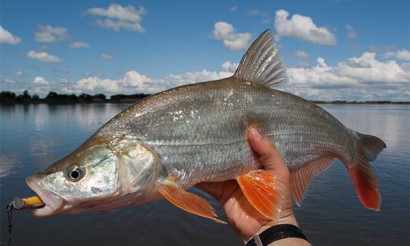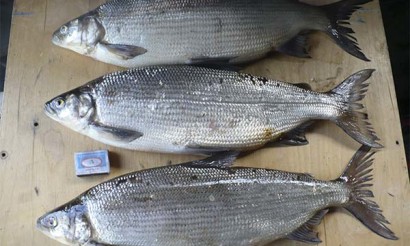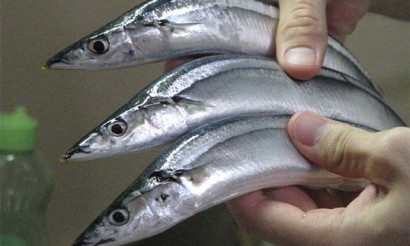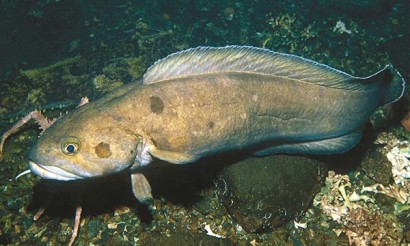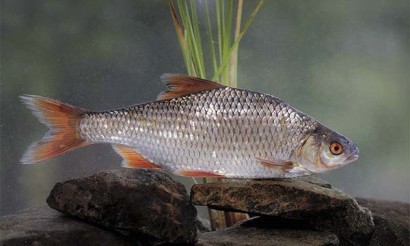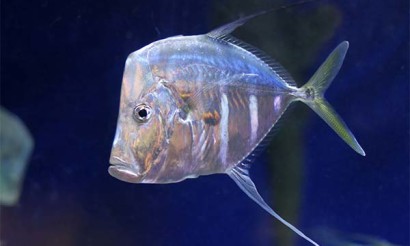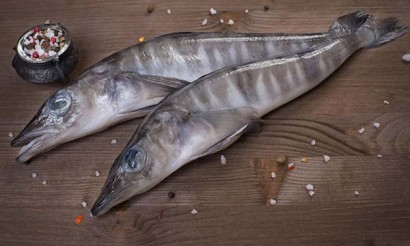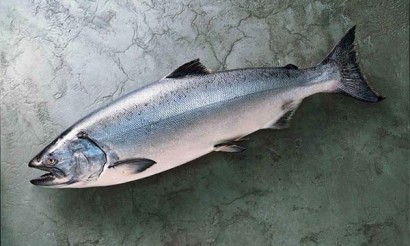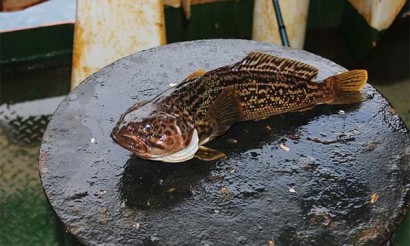Seaweed: useful properties of dried and canned kelp
The healing properties of seaweed have been known for a long time. Nevertheless, in the Western cuisine this product has not yet received due recognition. Meanwhile, sea kale is available and nutritious, it supplies the body with many vitamins, minerals and other beneficial substances.
- What is seaweed
- Types
- What is the difference between seaweed and chuca
- Composition and calories
- What is seaweed useful for
- General benefits
- For Women
- For Men
- In Pregnancy
- For breastfeeding
- For Children
- Seaweed chips: benefits and harms
- Is Canned Seaweed Healthy
- The benefits and harms of dried seaweed
- Can I eat seaweed while losing weight?
- Seaweed in medicine
- Diabetes mellitus
- For pancreatitis
- For Gastritis
- For Intestines
- For constipation
- For gout
- For colitis
- For the liver
- For hemorrhoids
- Pri cholecystitis
- Seaweed-based folk medicine recipes
- Seaweed in cosmetology
- For Face
- For Hair
- Harm and Contraindications
- Seaweed allergy symptoms
- How to choose and store seaweed
- Can I Freeze?
- How to Dry Seaweed
- How to cook Sea Sprouts: Recipes
- Sea Sprouts, Potatoes and Eggs Salad
- Frozen Seaweed Salad
- Porridge with seaweed
- Omelette with cabbage
- How to eat seaweed correctly
- How much you can eat per day
- Can I eat at night?
- Can I Eat Seaweed Raw?
- Can I Eat Seaweed during Lent?
- Can I Give Seaweed to Animals
- Interesting facts about seaweed
What is seaweed
Seaweed is a product derived from brown seaweed, such as Laminaria japonica Aresh, L. saccharica L. These seaweeds occur mainly in the Pacific Ocean, so the product is popular in the Far East, in the traditional cuisine of China and Japan. However, in these countries seaweed is also a medicinal agent.
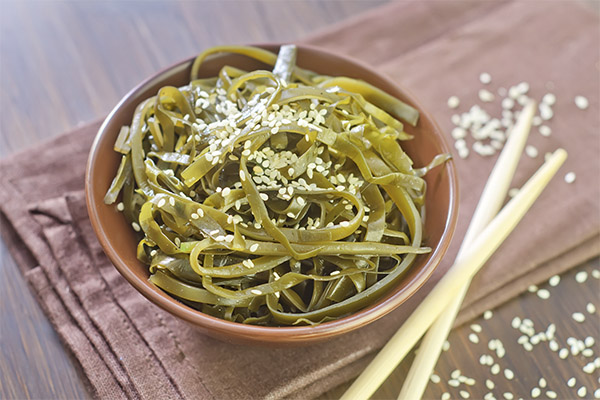
Types
In nature there are about 30 species of kelp, although not all of them can be eaten because of an unpleasant smell or taste. There are three main species of sea kelp used to supply the market:
- Japanese kelp, which is considered the most valuable in terms of its chemical composition. This type of algae is also used to make medicinal preparations.
- Sugar kelp. It is found mainly in the White Sea, the Kara Sea and the Barents Sea. In composition, it is inferior to the Japanese, it is less pleasant in taste, but it is often used for canning with various additives.
- Laminaria digitata. Characterized by a bitter-salty taste. In cooking, it is rarely used, but it has found wide application in pharmacology, where it is used to manufacture drugs against atherosclerosis.
Sea kale can be divided into two large groups: those that are used in medicine and those that are used in food. In addition to their taste qualities, they also differ in the content of iodine.
As for ready-to-eat seaweed used for food purposes, it also comes in several forms - frozen, canned (pickled) and dried.
How seaweed differs from chuca
Many people think that seaweed and chuca are the same thing. In fact, chuka is a ready-made dish, a salad. And in Russia and the Far East, they put a slightly different meaning into this concept.
It should be noted that chuka salad is a dish of Japanese cuisine. The word "chuka" means "Chinese". And it is not just one dish, but a variety of salads, and they have one thing in common: their ingredients are cut into thin slices. And among vegetables cucumbers and sometimes carrot are used more often; meat or ham and transparent rice noodles harusame can also be added. The dressing is based on vinegar and sesame oil. Kikurage mushrooms are also sometimes added. There is no seaweed in these salads.
In Russia, however, "chuka" is a seaweed salad, which in Japan is called "kaiso sarada". But it does not contain seaweed either, it is based on wakame seaweed (botanical name: Undaria peristaya), which has a pleasant delicate taste. The only thing they have in common with seaweed is that both products belong to the category of brown seaweed and are cut into straws. By the way, seaweed is called "kombu" in Japanese; it is added to miso soup and even used to make tea.
Composition and calories
Sea kale is a low-calorie product. Its energy value is only 49 kcal per 100 g of product.
But the main thing about it is its chemical composition. Laminaria is considered one of the best natural sources of iodine. Research shows that 1 kg of seaweed contains as much of this element as 100 thousand liters of sea water. That is why kelp is useful for those who suffer from certain thyroid diseases, because iodine deficiency leads to significant violations of the endocrine system. It is enough just to compare the figures: the daily requirement in iodine for a healthy person is 100-150 micrograms. A serving of dried kelp (100 g) contains up to 160-800 mg of this element.
Sea kelp in addition to iodine contains:
- Vitamins B1, B2 and B12, useful for metabolic processes and CNS activity.
- Pantothenic acid (vitamin B5), which is often called anti-stress vitamin - it is necessary for normal development of adrenal hormones, the formation of antibodies and strengthen the vascular system, the normal absorption of other vitamins.
- Folic acid (vitamin B9), which is necessary for normal immune and cardiovascular system, for cognitive function.
- Ascorbic acid and carotenoids.
- Polysaccharides - mannitol, fructose and a specific substance laminarin. They have anti-inflammatory and anti-tumor effects, and are also very useful for intestinal function.
- Magnesium, potassium, iron, nickel, zinc, copper.
- Bromine, which makes the body more resistant to stressful situations.
- Organic acids.
- Alginic acid - up to 13-54%, this substance has the ability to remove heavy metals from the body, not without reason alginates are called natural enterosorbents.
Also kelp contains oligosaccharides, which have anti-inflammatory effect. In addition, they are useful in the treatment of juvenile acne.
It is impossible not to mention that seaweed contains sterols, which are substances that fight bad "cholesterol". They have a beneficial effect on the condition of the blood vessels and allow a person to maintain youthfulness for a long time. It is in the consumption of such algae is the secret of health of the Japanese. A recent study has proven that genetics has nothing to do with it. The Japanese who stay in the Land of the Rising Sun are 10 times less likely to develop atherosclerosis than those who have migrated to Western countries. And it's all because of eating kombu - seaweed.
Studies have also proven that regular inclusion of this product in the diet can significantly improve blood counts thanks to sterols. These substances prevent high blood clotting and thus prevent the formation of blood clots.
What are the benefits of seaweed
General benefits
This product is beneficial at any age. Seaweed has a beneficial effect on the body as a whole, strengthens the immune system, improves memory and cognitive abilities. A number of studies show that it is very useful for vision. Also, seaweed can normalize blood pressure and stop inflammatory processes. Therefore, it is useful for hypertension, arthritis and some other diseases of the joints.
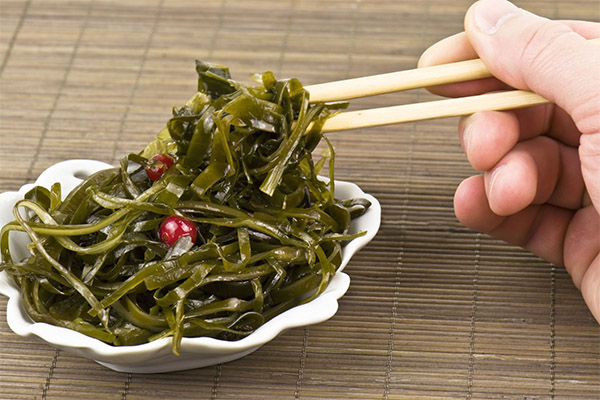
The substances it contains are involved in the process of hematopoiesis, ensure the function of the cardiovascular and nervous system.
For women
Seaweed is useful for the fair sex for several reasons at once:
- it normalizes reproductive function;
- it helps to get rid of excess weight;
- Prevents premature aging;
- Reduces the risk of cancer;
- Supports normal thyroid function.
In the absence of contraindications women are recommended to include sea kelp in their diet regularly to reduce the risk of malignant tumors of the breast, uterus and other organs of the reproductive system. This action of kelp is due to its ability to normalize the level of estrogen in the body. And the action of sterols allows you to normalize the menstrual cycle.
For men
The representatives of the stronger sex often ignore seaweed - as well as any herb. But in fact, do not underestimate its benefits for the male body. The fact is that the regular consumption of seaweed increases physical performance. There have been a number of experiments, which confirmed that kelp increases physical endurance and prevents the development of oxidative stress in the blood, which is typical for those who are engaged in such work.
Of course, for men iodine is as important as for women. After all, the lack of this substance negatively affects cognitive abilities and the nervous system. Seaweed can quickly make up for the lack of iodine, and thanks to this improved attention, increases the reaction rate, which is important for sports and professional activities.
Pregnancy
Seaweed is useful even during the planning stage of pregnancy, not to mention the period of carrying the baby. The fact is that it provides the body with enough folic acid, without which normal child development is simply impossible. In addition, it contains a lot of useful iodine, which is also necessary for normal pregnancy.
Finally, the substances contained in seaweed help to clean the body from harmful toxins. Also, this seaweed is good for cardiovascular activity. However, you should remember that during pregnancy you need to use any products, including seaweed, with caution, and at the first symptoms of allergies exclude it from the diet.
When breastfeeding
Sea kale contains not only iodine, but also useful amino acids that, among other things, improve the absorption of this element. In the postpartum period, many women face iodine deficiency, and with breastfeeding it becomes especially noticeable. So seaweed can significantly improve the situation.
Thanks to this product more quickly normalized hormonal background. Also seaweed allows you to remove toxins and eliminate the depression that is typical for the postpartum period. The regular consumption of seaweed strengthens the bones of mother and child. In addition, these seaweeds are useful because they can reduce blood viscosity, and as a result it has a beneficial effect on cardiovascular activity.
For children
Children need vitamins and minerals, and iodine also plays an important role in their development. That said, you should not include seaweed in the diet of young children. Some pediatricians believe that it should not be offered to babies until they are two years old, while others believe that you should wait until they are three. The fact is that at an early age the child's digestive system simply can not cope with such a product, because the appropriate enzymes will not be produced.
At the same time, even older children should be given sea kale with caution. The fact that there is always a risk of food allergies - so introduce the product to the diet should be with caution. In addition, a child should not eat seaweed in raw form, since it is unknown how it was stored in the store, how it was transported - during this time it could well have appeared pathogens.
For children, dried seaweed is considered the most useful option. Pediatricians recommend giving it for anemia, as well as to prevent diarrhea. In addition, dried seaweed is advised to be added to the diet when treating childhood obesity.
If after the age of three there is some delay in physical and mental development, it may be due to iodine deficiency. In this case, seaweed may be the easiest solution to the problem.
Ideally, the pediatrician recommends giving seaweed in boiled form, because it has no marinade that could harm the stomach. In addition, this product is guaranteed to be heat-treated. True, it is not always possible to persuade a child to eat just this kind of cabbage. The other options will be discussed below.
Seaweed chips: benefits and harms
It is no secret that not everyone likes the specific taste and aroma of this product, which is explained by the combination of sea salt and iodine. Nevertheless, there are ways of cooking that allow you to cope with this problem. In the East, dried seaweed is used to make thin plates that are eaten pure, and it is also used to supplement first and second courses. In Asia, they are also used to drink green tea, which is also rich in antioxidants.
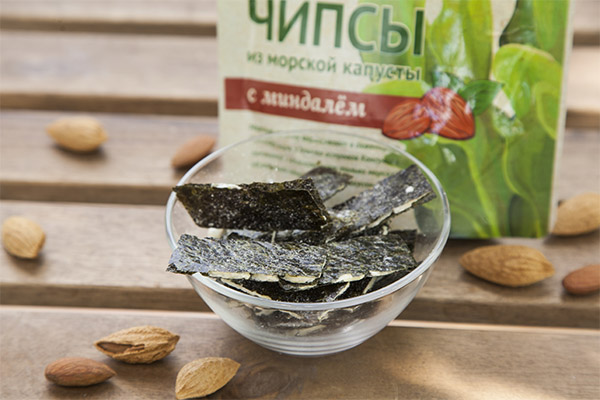
The thin plates are called chips. They can be healthy - it all depends on how exactly the manufacturers have tried to soften their taste and flavor. For example, seaweed chips cooked in sesame oil will be quite healthy - unlike their potato counterparts. However, this does not apply to spicy and salty seaweed chips. It's just not too unhealthy a snack.
Some companies produce chips with healthy additives - wasabi, ginseng (they are very useful for increased physical activity), with dried fruit or ginger. You should not get carried away with such chips either, although their energy value is relatively low. The same standards apply to them as to seaweed in general, discussed below.
Is canned seaweed good for you?
Sea kale is a source of iodine and retains its beneficial properties even when canned. Of course, in this case it contains fewer vitamins, because some of them are destroyed after thermal processing. But the iodine is mostly preserved, so that the quality canned seaweed remains useful.
In cans the cabbage is sold seasoned with vegetable oil and onions, which increases its fat content. As for the extraneous impurities, they are due to the fact that the seaweed was mainly caught from the sea and had time to absorb those harmful elements that are contained in the water. These can be heavy metals or polychlorinated biphenyls, for example. Fortunately, at most plants, the raw material is tested before being rolled into jars, so there is no health risk.
Another important point is the salt content; some manufacturers may have it higher than the norm, which negates the seaweed's ability to lower blood pressure. Vinegar-based marinades, which are used in canning, can be harmful to the digestive system.
It should be noted that some companies have tried to reduce the harm caused by the processing typical of canning. Today, some of them use canning technology. It does not use vinegar, only table salt and antiseptic, heat treatment is also minimal, and most importantly - it is tightly packed in a special container. As a result, sea kale retains all the useful substances. Such preserves are often produced with the addition of vegetables, fish and seafood, meat and pickled beets, garlic, tomato sauce.
The benefits and harms of dried seaweed
Dried seaweed retains all the useful properties of fresh seaweed. It consists of vegetable protein by 5-20%, carbohydrates by 6-12%, and it contains iodine up to 0,6%. At the same time it contains other vitamins and minerals, it has low caloric value, so it is often recommended to be used for days of dieting.
The fact is that dried seaweed is subjected to only a slight heat treatment. But it is impossible to avoid this stage, because fresh kelp consists almost entirely of water. During drying, extra moisture goes out of it, and all the useful properties remain.
Can I eat sea kale while losing weight?
Sea kale is considered a great dietary product that can and should be used for weight loss and obesity treatment. This is due to its composition as well as to its anti-inflammatory properties (the latter are very important in cases where there is a relationship between overweight and diabetes).
Theoretically, in order to get rid of extra pounds, it is sufficient to simply eat up to 50 mg of dried kelp a day and stick to a strict diet. If a person is not ready for this neither physically nor psychologically, another approach can be used. Sea kelp can be made the main component of the diet. The fact that it contains almost all the necessary substances for the body, so that such a diet will be only good for your health.
At the same time, sea kale contains fiber. In the stomach it swells, there is a feeling of its fullness, the feeling of hunger is blunted, the appetite is reduced. But only seaweed should be pre-prepared by pouring cold water for 10 hours. After that, it should be cooked in the following way.
Sea kale in this diet can and should be combined with other foods. The diet should include eggs in boiled form, as well as dietary meats. On one day the seaweed can be combined with eggs, on another - with meat. Drinking tea or rosehip decoction is recommended. The diet should be observed for two weeks. If so far it is difficult to endure such a regime of diet, the duration can be reduced to one week. The maximum amount of seaweed is 300 grams per day.
Also on the basis of seaweed make wraps that can reduce the volume of the hips and cope with cellulite.
Sea kale in medicine
The usefulness of seaweed is considered proven - it is used for hypertension, arthritis, inflammatory gynecological diseases, etc. However, there are certain peculiarities of seaweed application in one or another case.
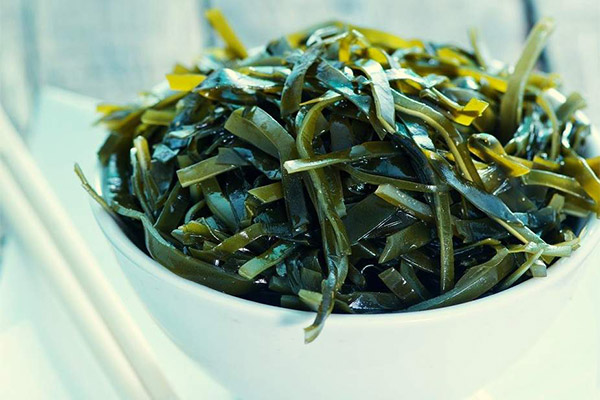
In diabetes
Sea kale in diabetes is very useful. The substances it contains stimulate the synthesis of insulin and normalize the work of the pancreas and parathyroid gland, so diabetics not only can, but literally need to consume it on a regular basis. Moreover, it contains tartaric acid, which prevents the deposition of bad cholesterol and helps to reduce weight - both of which are very important in diabetes.
Sea kale also helps fight the complications of this disease. It helps prevent visual impairment and adrenal gland dysfunction, which are found in the development of diabetes. And also seaweed improves the cerebral circulation and has an anti-inflammatory effect, accelerates the healing of wounds and ulcers, which also plays an important role.
Important: The glycemic index of seaweed is 22 units.
In pancreatitis
Seaweed has anti-inflammatory properties. But in the acute form of pancreatitis, it is not recommended to include it in the diet. It can be eaten only in the chronic form of the disease in remission. And you should remember that in this case you should include in your diet boiled or dried seaweed - its constituent substances will help to normalize the pancreas function. But you can not eat pickled cabbage, even if no vinegar was used for its preparation - it will cause increased production of pancreatic juice, which can cause a worsening of the disease.
Gastritis
This is an inflammatory disease, and at its exacerbation seaweed can not be eaten, only at the stage of stable remission. In this case, it is advised to include in the diet boiled seaweed (for example, add it to soup) or dried, using it instead of salt.
For the intestines
Seaweed in general has a beneficial effect on the human digestive system. But with inflammatory bowel diseases, the same restrictions apply as for the above pathologies of the pancreas and gastric mucosa. That is, seaweed is added to the diet only in the presence of a stable remission and only in boiled or dried form.
For constipation
As noted above, seaweed contains polysaccharides. They are prebiotics, that is, they create a favorable environment for the reproduction of beneficial intestinal microflora. That is why seaweed is considered an effective remedy for constipation caused by dysbacteriosis or irritable bowel syndrome.
However, seaweed has another mechanism of action that puts it on a par with the most effective mild laxatives. Thanks to this mechanism, it helps with functional constipation, which is associated with a deterioration of the intestinal receptors. Fibers contained in seaweed, in the stomach, swells, and in the intestines, it gets, already greatly increased in volume. This leads to irritation of the receptors, which causes bowel emptying. And unlike many other remedies, seaweed is not addictive, it just helps the intestines to perform their duties, and so the product can be included in the diet on a regular basis.
In case of gout.
This disease is associated with a disorder of the salt metabolism. It involves the deposition of crystals of uric acid salts in certain joints. Seaweed can prevent the formation of such complications. The specific recipe for its use will be discussed below.
In colitis.
This disease is associated with inflammatory processes in the intestines. Seaweed in the stomach swells, and moving further along the gastrointestinal tract, irritates the mucosal receptors. Therefore, it is contraindicated in acute colitis (or exacerbation of chronic disease).
For the liver
Seaweed is very useful for the liver. It contains various polysaccharides, of which the most valuable for the liver are alginic acid and mannitol. The latter is widely used in pharmacology, as it acts as an enterosorbent that neutralizes and eliminates toxins. But at the same time mannitol stimulates bile excretion.
As for alginic acid, it can also bind and excrete some hazardous substances from the body, in particular - salts of heavy metals. Thus, both of these components help the liver to perform its functions, providing it with additional protection.
Laminaria, among other things, contains many plant proteins, antioxidants, minerals and fats, which are also beneficial for the liver cells.
In hemorrhoids.
Despite the fact that in general seaweed is beneficial for the intestines, it is contraindicated in hemorrhoids.
When cholecystitis.
If this disease is not accompanied by the formation of stones, there is no reason to reject seaweed. On the contrary, it will be very useful, because it will help get rid of edema and remove toxins. Also seaweed in this disease can partially replace the forbidden salt.
Folk medicine recipes based on seaweed
In China, seaweed has been used as a medicinal plant for centuries. In domestic folk medicine, it is assigned a somewhat more modest role. Nevertheless, seaweed can be used for a variety of pathologies.
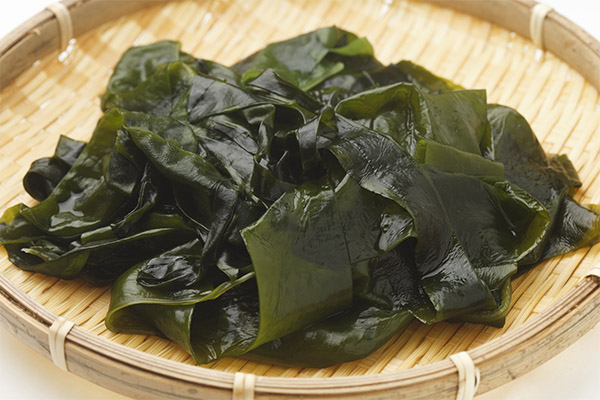
Recipes:
- In the case of upper respiratory tract disease, seaweed is recommended for inhalations. For this take 2 tbsp of dry material, pour 1 liter of boiling water and insist for 10-15 minutes. It is best done in a kettle - when the mixture is infused in his nose put a piece of paper rolled into a cone, and breathe over it in the steam for 10-20 minutes.
- Infusion kelp will help rheumatism and inflammatory diseases of the joints. To do this take 2 tbsp. dried kelp and insist in a thermos for 12 hours. Then take a bath, pouring into hot water with the resulting infusion.
- With gout remedy based on seaweed taken internally. To do this take 1 tsp. without a hill of crushed dried kelp for 150 ml of hot water (not boiling water). The remedy is infused until it cools. Take it at night, but taking into account that it can act as a mild laxative.
- To combat atherosclerosis take 1 tsp. powder of dried kelp and pour 50 ml of boiling water. Insist until it cools. The entire volume is divided into three equal parts and taken three times a day before meals.
Sea kale in cosmetology
Seaweed is widely used in cosmetology. It is mainly useful in that it helps to establish the sebaceous glands. In this regard, masks based on seaweed are used to treat acne. Also due to the high concentration of vitamins, minerals and hormone-like substances, they rejuvenate the skin, tighten it, improve the facial contours. In short, it is difficult to overestimate the importance of this algae in cosmetology.
For the face
For the face on the basis of seaweed make various masks, which relax the muscles, tone the skin, nourish and moisturize it, help to clean pores and remove dead cells and even to a certain extent provide regeneration. Some examples of these recipes are:
- Rejuvenating Mask. For 3 tsp. dried kelp take 5 tsp. boiling water and thoroughly mix the ingredients until a homogeneous mass is obtained. Close the lid tightly to allow the mixture to infuse. It takes 10 minutes - a slimy mass should remain in the container, a few drops of freshly squeezed lemon juice should be added and mixed. The remedy is applied to cleansed skin and left on the face for 30 minutes. Then rinse off with warm, but not hot water. Mask do three times a week, more often is not necessary, especially since lemon gives some whitening effect.
- Nourishing mask based on seaweed, peach oil and honey is suitable for dry skin. Take 1 tsp. The mixture of dried seaweed, pour in so much water that when mixed you get a mass with a consistency similar to that of cream. Then add to this mixture 1.5 teaspoon of peach kernel oil and the same amount of honey. The remedy is mixed and applied to a cleansed skin for 20 minutes, and then washed off with warm water.
- Whitening mask on the basis of seaweed. Take 1 tbsp. swollen raw material (from dried kelp), add some fresh lemon juice and 1 tbsp. sour cream. Apply the mixture to cleansed skin and leave for 10 minutes, then rinse with warm water.
There are many variations on the theme of such masks. For example, for normal skin, a nourishing mask prepared not only on the basis of seaweed and peach oil, but also with the addition of raw egg white and lemon juice. With problematic skin prone to inflammation - use aloe juice.
For Hair
Seaweed, rich in vitamins and minerals, can accelerate hair growth, including by improving the blood supply to the hair follicles, as well as nourishing the scalp and helping to get rid of seborrhea. The following remedies are used for this purpose:
- Hair growth mask. For 2 tbsp of powder of dried seaweed take 100 ml of water (and it is better to take mineral, but not carbonated), 2 tsp of burdock oil. Some recipes add onion juice, but that's optional. Sea kale in advance pour water (about 1.5 hours before applying the mask). Oil is heated slightly in a water bath, then mix the components and apply to the scalp and the entire length of wet hair. At the same time it is necessary to lightly massage the skin. After that, the head is wrapped with plastic wrap and towel to create a greenhouse effect. After 40 minutes, the mask is washed off. If onion juice was used, you can't keep it longer than 20 minutes, otherwise the skin will burn.
- Mask for strengthening hair. Take 2 tablespoons of seaweed powder, the same amount of colorless henna, a glass of water to dilute these components. Dilute the dry components with water separately, then combine and mix thoroughly. Then put in the composition of 1-2 tsp. of coconut oil, pre-melted in a water bath. Apply to wet hair along the entire length for half an hour.
Both masks wash out with shampoo, and then rinse with water and a little lemon juice. This fixes the effect and helps get rid of unpleasant odors.
Health Hazards and Contraindications
Many people fear that the use of seaweed can cause iodism. In fact, this disease is more related to the consumption of inorganic iodine. And that element, which is contained in seaweed, is perfectly assimilated by the body and does not cause any harm. But this product has its own side effects and contraindications.
Seaweed is categorically contraindicated:
- for hives;
- tuberculosis;
- furunculosis;
- hemorrhagic diathesis;
- abnormalities of the endocrine system;
- Chronic rhinitis.
Also, it is not recommended to use at exacerbation of renal diseases and abnormalities of the gastrointestinal tract.
Seaweed allergy symptoms
Mostly allergic reactions occur in people with hypersensitivity to iodine. In this case, the symptoms may be purely external - it is hives or other types of allergic rash, accompanied by the appearance of itching. But in some cases, the problem may be more serious - difficult breathing, swelling, severe rhinitis, in severe cases - bronchospasm and Quincke's edema. In the presence of such reactions, you need to stop contact with the allergen and take an antihistamine drug.
How to choose and store seaweed
To choose seaweed, you need to know what to pay attention to. If we are talking about frozen cabbage or preserves described above, it is worth giving preference to a product in a transparent package, as it will be easier to see:
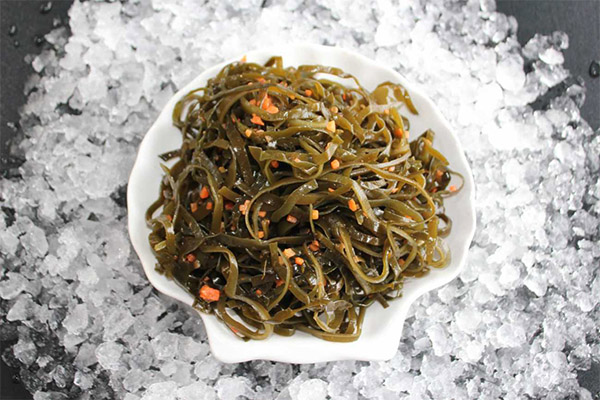
- When choosing frozen seaweed, it is important to consider: in the package, it should have a clearly defined straw shape of dark green color. A yellowed product is likely spoiled. A bright green color indicates a fake. Under no circumstances should you buy a mushy product. If you can see ice in the package - you should also refuse to buy it. The thicker the seaweed straw, the better - this means that the seaweed has matured for quite a long time and contains many vitamins.
- When choosing pickled seaweed, it is also recommended to give preference to transparent packaging in order to consider the texture - it should be clear. The packaging should indicate the origin of the seaweed. Barents Sea is not considered the best option, the ideal product should come from the Pacific Ocean, and it can be produced both in Russia and in China - it does not really matter. The cabbage should be covered in brine by a third and no more. The composition may include additives - vegetable oil, spices, lemon juice. What it should not contain is vinegar and preservatives. The food additive E211 is considered allowed by the Ministry of Health, but it destroys those useful substances that are contained in the seaweed.
- Dried seaweed is sold by weight or in bags. The second option is considered preferable. The bag should be intact, without any signs of damage. If it is transparent, you can visually check that its contents are free of foreign impurities. The plates of dried kelp should not be glued together.
Sea kelp can also be purchased in tins. The advantage of such canned foods is that they have been heat-treated, so fewer preservatives are added to them. However, in fact, the buyer is buying a "cat in a poke" because he cannot look inside the jar.
Do not buy seaweed by weight. So the buyer simply does not know what spices and additional ingredients were used in the production of the product.
Storage conditions depend on both the type of cabbage and its packaging. For example, frozen sea kale can be stored in the freezer for a long time - up to 30 days. Canned goods in the refrigerator, if they were packed in plastic, are stored for up to 72 hours after opening. Product in a tin can after opening is recommended to put in a glass container, where it can be stored for no more than two days (of course, in the refrigerator). Dried seaweed is stored in a dark, dry and cool place. The shelf life is 3 years.
Can I freeze it
Sea kale can be frozen - it does not lose its useful properties. Shredded kelp is frozen in briquettes at a temperature of -15-18 ° C, but it is most often done in industrial conditions.
How to dry kelp
Theoretically, sea kale can also be dried at home, but only if a suitable place for drying can be arranged. This should be a rocky area, protected from the wind. It will be necessary to install a shed on it, since the technology involves natural drying of kelp.
It is recommended to put a planking on the plot, its height should be 15-20 cm above the ground level. Before spreading the seaweed it should be washed with water and treated with some disinfectant.
The kelp should be thoroughly washed in seawater so that no sand or other natural impurities remain on it. The petioles should be cut off. Algae should be sorted out, leaving only the whole ones. For drying, they need to be carefully spread out and spread out. For the process to take place in natural conditions, you should dry only in good weather, spread out the seaweed on the deck in the early morning. If you do it later, the upper layers of seaweed will be too dry. In addition, the most valuable part - the foliage - can curl up. Interestingly, this happens most often in the first half of the day, so you need to turn them every 2-3 hours.
In general, the most productive period for drying is considered a sunny day between 8 a.m. and 3 p.m. During this time the seaweed loses up to 70% of its moisture. Seaweed in this case acquires a smooth surface on which no salt deposits are visible. It can be stored for a long time. It should be placed under a canopy overnight, and can only be spread in the morning when the area is dry from the dew. As a rule, it will be possible to dry seaweed within two days. Drying seaweed longer than this is not recommended, as it can get moldy.
How to cook seaweed: recipes
From pickled or boiled seaweed most often prepare salads, trying to soften the specific taste and smell of the product. In addition, kelp can be added to a variety of vegetable, meat and fish dishes, it is also combined with seafood. In Russian cuisine it is added to traditional soups - for example, cabbage soup or rassolnik. You can cook with it and vegetable stew, to which the seaweed gives a little unusual taste.
But whatever dish you cook with it, you need to prepare the raw material properly. So, the frozen seaweed should first be rinsed in running water and then cooked for literally 1 to 3 minutes.
With dried seaweed will be more work. First it should be washed in cold water, then soaked for 10-12 hours to make it swell. The recommended proportion is 5-6 parts of liquid for 1 part of kelp. You can take both fresh water and slightly salted water. Then bring the mixture to a boil and leave on low heat for 15-20 minutes. Drain the decoction and boil the kelp again. This greatly improves its flavor and aroma. When the sea kelp is ready, it can be poured with mushroom brine - the taste will be unusual, but tangy and pleasant.
Experienced cooks offer such recipes.
Salad with seaweed, potatoes and eggs
This is a great option for a winter menu, when there is a lack of vitamins in the diet. For 300 g of marinated seaweed take 4 eggs, 1 sour apple, 1 boiled potato, 2-3 tbsp of olive oil for dressing. Salt may not be added to such a salad. In a salad bowl, put the seaweed, add pre-shredded boiled eggs, an apple, chopped julienne and sprinkled with lemon juice, as well as a finely chopped potato. You can add some lettuce leaves. Some recipes recommend cutting eggs into large slices and decorating the dish with them.
Salad based on frozen seaweed
For making this salad you need: 200 g of frozen seaweed, 100 g of white cabbage (you can replace it with Peking cabbage), 1 fresh cucumber (the so-called "English" one is better - long and with smooth skin), herbs, some salt or spices and olive oil for dressing. Sea kale needs to thaw, after which it is washed, shredded and cooked in lightly salted water for no longer than 15-20 minutes. Then the liquid is drained, and the cabbage is thrown in a colander, cooled, mixed with chopped vegetables, pour the dressing and sprinkle with chopped herbs.
Porridge with seaweed
To prepare you will need 200 g of pickled kelp, 1 potato, 1 carrot, 1 onion of medium size, 3-4 pickles, 1 tsp. butter, salt and sour cream - to taste. Rassolnik is cooked in the traditional way. You can add rice or barley grits to it. Pass the cabbage, add it to already boiling rassolnik and boil for 3-5 minutes. Serve with sour cream.
Omelette with Cabbage
Children can be given an omelet with seaweed. You need to take 2 eggs, beat them, pour into a container with them 30 ml of milk and whisk thoroughly, and immediately before baking in the oven add 2 tsp. dried seaweed, previously poured warm water to swell. The omelet is cooked in the oven or in the microwave for 4-5 minutes, then placed on a plate with the vegetables and offered to the baby.
How to eat seaweed correctly
This product is consumed in boiled, stewed, dried form. Not everyone tolerates the taste and smell of seaweed. To get the benefits, you can add it instead of salt in soups, fish dishes and salads - it will not affect the taste practically.
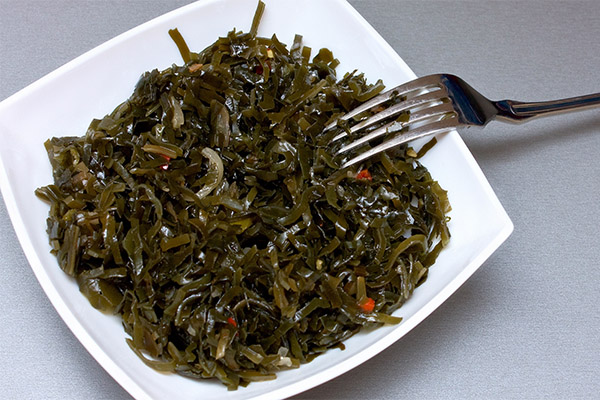
How much you can eat a day
An adult can eat up to 250-300 g of seaweed per day in boiled, stewed or pickled form. The maximum amount of dried kelp because of the higher concentration of iodine is 2 tsp.
Children should eat no more than 15 g of seaweed per day. Gradually the amount can be increased, but taking into account that you can eat up to 60 g of kelp per week. This applies to cooked or stewed kelp. In dry form, the maximum dosage is 1 tsp. per day.
Can I eat kelp at night?
Sea kelp is a low-calorie product, it is easy and quickly digested, it can be eaten at any time of the day. Some nutritionists even believe that at night this product is useful to eat those who suffer from constipation - the desired effect of kelp will give just the morning.
Is it possible to eat raw
It is not recommended to eat seaweed raw, because it consists almost entirely of water. Therefore, kelp is eaten only in a boiled, stewed, pickled form.
Can I eat seaweed during Lent?
During Lent, sea kelp is allowed to eat. And this is very good, because during the entire Lent, severe restrictions on seafood can lead to iodine deficiency.
Can I Give Seaweed to Animals
Seaweed is useful not only for humans, but also for animals. For pets, it is also an irreplaceable source of iodine. This element has a beneficial effect on the condition of the skin and coat, strengthens the immune system and increases resistance to infectious diseases. Iodine is especially good for dogs; it has a calming effect, which is very good for excitable animals. In addition, pets who regularly get seaweed with their food are less likely to suffer from parasitic infestations.
However, dog owners should be aware that when iodine is added to the pet's diet, this substance affects the color of the pet's coat, increasing its pigmentation. That is, if in the normal state the dog has a reddish or brownish shade of hair, with the regular use of seaweed, the color will become even brighter and richer. But this is not the problem. The coat of snow-white animals when consuming this product begins to turn slightly yellow. This may not even be noticeable if you do not compare such an animal with its normal relatives. For an ordinary dog it may not be so important, but for those who participate in exhibitions, it is a fundamental point. And the color is eliminated rather quickly, so the main thing is not to give kelp just before the show.
Animals are mainly given dried seaweed, which should be crushed beforehand. Such supplements are usually sold in pharmacies.
It is recommended that dogs be given kelp from the time they are 1.5-2 months old. The initial dosage should be minimal - literally on the tip of a knife. The dosage increases gradually, and already by one year, representatives of medium breeds can be given 1 tsp of dried seaweed, and large animals - and 1.5-2 tsp. But, of course, they are added to the diet not every day, and in some one feeding no more than twice a week.
Interesting facts about seaweed
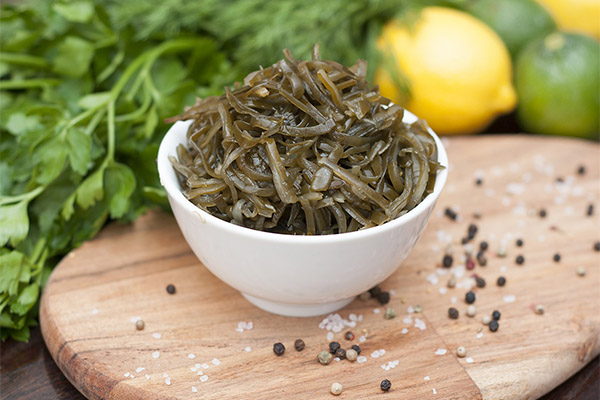
- Seaweed is an algae, which is why it contains so many biologically active substances. In particular, science has proven that sea plants contain 2-3 times more vitamins than land plants.
- Brown seaweed, from which frozen and dried seaweed is prepared, is harvested mainly from the ship, since it only appears on the surface during high tide.
- At the same time, seaweed farms are gradually developing. The fact is that kelp can safely be called the fastest growing crop in the world. Experiments carried out in China showed that one hectare of seaweed can yield up to 500 tons of algae, which exceeds the results of any crop.
- When harvesting any algae, there are many rules to follow in order to preserve its medicinal properties. Whole kelp beds are considered to be the most useful, one should try to keep them without letting the algae dry up. However, it is difficult to transport them, which is why in cosmetology, and in cooking, a cheaper option is often offered, which is the crushed particles of dried seaweed.
«Important: All information on this site is provided for informational purposes only. for informational purposes only. Please consult with your health care professional before using any of the recommendations. specialist before using any of the recommendations. Neither the editors nor the authors shall be liable for any possible harm caused by materials."

